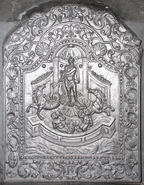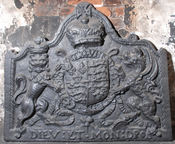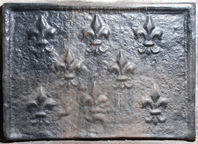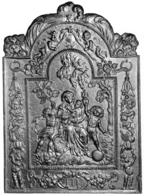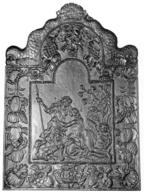-
87
Description: 'Dutch' style; cavetto-canted arched rectangular shaped central panel, double fillet and bead edging, figure of Poseidon/Neptone, trident in right hand, standing on three scallop shells, within a niche with a demi-hemispherical roof and two sloping supporting walls, on either side is a mythical seahorse, below is a walled fountain base with two mermaids at the front; cavetto-canted arched rectangular shaped border with scallop and clam shells separated by swirled foliage, monogram at base between scrolled foliage; on top, scrolled foliage.
Notes: From a design in 'Nouveaux livres de ...Statues [etc.]' (La Haye & Amsterdam 1702-5), by Daniel Marot.
Copies of this fireback are known.
Inscription: EB
- Decoration tags:
- 'Dutch' (shape)
- fillet (edging)
- whole carved pattern
- pictorial
- mythological
- monogram
- text
- animals
- humans
- objects
Manufactured: in the early 18th century in England.
Current location: Hampton Court, Richmond, Greater London, England.
Museum number: 1098 (part of the Royal Collection museum group)
- Attached to series:
- EB series
- British 'Dutch' style firebacks
-
89
Description: Quasi-arched rectangular shaped, with sides leaning slightly towards the top; wide ovolo edging (top and sides) with twisted rope relief; Tudor shield, garter, crown and supporters (crowned lion and dragon); motto along base; irregular ribbon behind.
Notes: Whole pattern; strong stylistic similarities with a Buckhurst arms fireback (no. 491), an example of which is at Michelham Priory, near Hailsham, East Sussex, suggest a common pattern maker and possibly furnace.
Inscription: DIEV ET MON DROI
Arms: Tudor royal (prob. Elizabeth I)
- Decoration tags:
- quasi-arched rectangular (shape)
- ovolo, simulated rope (edging)
- whole carved pattern
- armorial
- royal
- text
Manufactured: in the late 16th century in the Weald area of England.
Current location: Hampton Court, Richmond, Greater London, England.
Museum number: 1241 (part of the Royal Collection museum group)
- Attached to series:
- Ornate border series
- Tudor royal armorial firebacks
-
90
Description: Rectangular; ovolo moulded edging (top and sides); eight impressions of a fleur de lys, arranged in three horizontal rows (3-2-3), carefully spaced.
Notes: The same fleur de lys stamp has been noted on several firebacks, indicating a common source.
Copies of this fireback are known.
- Decoration tags:
- rectangular (shape)
- ovolo (edging)
- carved stamps
- heraldic
- objects
Manufactured: in the mid to late 16th century possibly at Pounsley Furnace, Framfield in the Weald area of England.
Current location: Hampton Court, Richmond, Greater London, England.
(part of the Royal Collection museum group)
- Attached to series:
- Pounsley series
-
92
Description: Arched rectangular shaped; paternost bead edging (top and sides); Stuart royal arms: shield, garter, helm, crown, crest, supporters and motto; date split between top corners; initials split beneath supporters.
Notes: Firebacks with royal arms attributable to the reign of James II are, inevitably, uncommon owing to the brevity of his reign. Paternost beads are more usually found as edging on ‘Dutch’ types of fireback. A polychrome casting of this fireback is displayed as the royal arms in St James's church in North Cray, Kent.
Copies of this fireback are known.
Inscription: 1687 /HONI SOIT QUI MAL Y PENSE / I R / DIEU ET MON DROIT
Arms: English Stuart royal (James II)
- Decoration tags:
- arched rectangular (shape)
- bead-and-pellett (edging)
- whole carved pattern
- individual numbers
- armorial
- royal
- text
Manufactured: in 1687 possibly in the Weald area of England.
Current location: Hampton Court, Richmond, Greater London, England.
Museum number: 1010 (part of the Royal Collection museum group)
- Attached to series:
- James II royal armorial firebacks
- Stuart royal armorial firebacks
-
308
Description: Arched rectangular centrel panel with bead on fillet edging; central seated female with an infant in her arms, a swan at her feet and a standing child on each side, the one to her left facing the front and holding aloft a flaming heart, its foot on a ball; the child to her right facing the back, holding aloft a branch in its left hand, all on a ground with a tree behind to the right; arched rectangular border with fillet edging; at the top of the arch a cartouche from which are suspended two ribbons, each held by a putto, from which cascade flowers and fruit, each lower part hung from a ring; two putti are on each side, one climbing on the suspended ribbon, the other at its foot; at the bottom, a cartouche containing the monogram between two clusters of flowers each suspended on a ribbon tied to a scroll; on top, two descending cornucopiae.
Notes: The scene portrays Charity; the same central panel can be seen with different borders, and also exists in other versions.
Copies of this fireback are known.
Inscription: HIS
- Decoration tags:
- 'Dutch' (shape)
- fillet (edging)
- whole carved pattern
- pictorial
- allegorical
- monogram
- text
- humans
Manufactured: in the late 17th century in the Siegerland area of Germany.
Current location: Hampton Court Palace, Richmond, Greater London, England.
Museum number: 1069 (part of the Royal Collection museum group)
- Attached to series:
- 'Dutch' HIS series
- Charity firebacks
-
309
Description: Central panel, cavetto-canted rectangle with arch; bud and annulet edging (in alternate threes); pictorial panel portraying Europa being carried to sea by Zeus, disguised as a bull; two female attendants wave from the right shore; two putti attend, one below with a bow and arrow; trees to right and left; clouds and sun above. Same shaped, fillet-edged border with floral scrolls top and sides; at the bottom, a cartouche bearing EB monogram between oak leaf and acorn fronds; on top, central scallop shell between floral scrolls with dolphin’s heads.
Notes: The central design is closely based on an illustration by Bernard Salomon, first published in a 1557 edition of Ovid’s Metamorphoses and copied in subsequent editions by Virgil Solis (1514-62). The initials, EB, are likely to be those of the pattern maker. The similarity between the execution of this picture and those on firebacks bearing the SHR monogram suggests the possibility of a common source. Ten rivets are the result of later repair.
Copies of this fireback are known.
Inscription: EB
- Decoration tags:
- 'Dutch' (shape)
- fillet (edging)
- whole carved pattern
- pictorial
- mythological
- monogram
- text
- animals
- humans
Manufactured: in the early 18th century in England.
Current location: Hampton Court Palace, Richmond, Greater London, England.
Museum number: 1107 (part of the Royal Collection museum group)
- Attached to series:
- EB series
- British 'Dutch' style firebacks
-
310
Description: Arched rectangular central panel with bead edging; pictorial scene of Venus, naked and kneeling, and Adonis, standing, holding a spear in his left hand, with Cupid to the left, and a hound and a quiver of arrows below to the right; arched rectangular border with fillet edging; descending swags of fruit and seashells enclosing the central panel; inscription in an oval cartouche at the bottom; on top, a Holy Roman Imperial crown between two mirrored dolphins, heads downward.
Notes: The scene is based on the painting (c.1635) of Venus and Adonis by Peter Paul Rubens; the initials, L8G, denote the style of border - other firebacks having the same inscription have the same border - and other borders are denoted by similar inscriptions (e.g. L6C and L7C). Von den Driesch (p.520) illustrates the same central image within an L7C border.
Copies of this fireback are known.
Inscription: L8G
- Decoration tags:
- 'Dutch' (shape)
- fillet (edging)
- whole carved pattern
- pictorial
- mythological
- text
- humans
Manufactured: in the late 17th century in the Siegerland area of Germany.
Current location: Hampton Court Palace, Richmond, Greater London, England.
Museum number: 1042 (part of the Royal Collection museum group)
- Attached to series:
- 'Dutch' LC/G series
- Venus and Adonis firebacks
